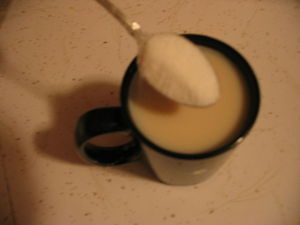Got milk? Most of us associate milk with children and their high calcium needs for growth. But milk is better for adults than perhaps you think in our age where we are told to drink 6+ glasses of water per day.
Most adults I know worry about the fat content in milk and all the “bad” calories we associate with milk. After all, one 8 oz glass of regular vitamin D milk has 150 calories, 70 of them from fat. Compared to zero calories from water, it seems like a no-brainer.
But water not only has no calories, it has no nutrition beyond simple hydration, a task achieved just as readily by any caffeine-free and alcohol-free beverage! Water is hydrating, but otherwise empty.
By contrast, 8 oz of regular vitamin D milk has 8 grams of protein (16% daily value), 4% vitamin C, 25% vitamin D, and 30% of our daily needs for calcium. In an age where we are all deficient in both calcium and vitamin D and where research is showing that pill-based calcium can lead to increased risks for heart attacks, it becomes more important than ever to meet our daily needs for calcium naturally, through the foods we eat. Milk is the obvious choice.
But what about all those calories and fat in milk? Aren’t they bad?
It turns out that, contrary to what we’ve been told in the media, a calorie is not just a calorie, that the source of each calorie matters. The most simple source of our calories is glucose which our bodies use directly via the liver.
Fructose is a larger molecule the body will either convert to fatty acids or glucose, depending on its needs, through the liver. The fructose-derived fatty acids are synthesized into triglycerides in the liver, then transported to fat and muscle tissues by the carrier molecules, very low density lipoproteins, or VLDLs.
Sucrose is broken down in the stomach into glucose and fructose which are both transported to the liver for use.
Lactose is the source of most of our calories from milk. It’s “milk sugar” if you will. According to Live Strong, “Lactose is broken down in the small intestine to equal quantities of glucose and galactose by the enzyme lactase. Galactose is absorbed into the bloodstream and transported to the liver where it is converted to glucose. Glucose-derived galactose is either stored in the liver as glycogen or released back into the bloodstream and transported to other tissues to make energy or build macromolecules. So, like fructose, galactose is also not a direct energy source for other tissues.”
Or, put simply, our bodies expend a lot of energy breaking down lactose and its components in the intestines and liver. It’s one of the most complicated sources of energy our bodies can utilize. Therefore, lactose has a low glycemic value, taking significantly longer to process and enter the body as blood sugar. Low glycemic sugars are ideal for diabetics in particular who must diligently avoid blood sugar spikes after eating, making milk and other dairy products ideal for helping diabetics manage their blood sugars.
So next time you are thinking about a glass of water to beat the summer heat, consider milk instead. The calories you consume won’t spike your blood sugar, you’ll receive nutrients your body craves, and you’ll stave off many adult health concerns.
Got milk?


